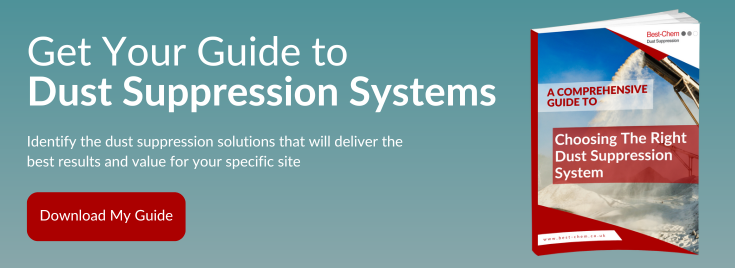
Is a High Pressure Misting System Right for Your Business?
Airborne dust poses a constant challenge in quarry operations, affecting visibility, machinery performance, workers’ health, and regulatory compliance. As environmental standards tighten and the demand for cleaner, more efficient processes grows, many quarry operators are looking for the most effective soloution for dust suppression.
In this article, we’ll explore whether a high pressure misting system is the most effective solution for your business’s operations.

What Is A High Pressure Misting System?
High pressure misting systems are widely used for dust suppression across industries, such as quarrying, mining, demolition, recycling, and cement production. Operating at pressures between 700 and 1,200 psi, these systems produce ultra fine water droplets that form a dense mist capable of binding airborne dust particles and pulling them to the ground. This mist binds airborne dust particles and pulls them to the ground. Unlike traditional spraying methods that can saturate work areas or create slippery surfaces, high pressure misting delivers effective dust control with minimal water usage, making it well-suited for high dust environments like quarries.
What Are The Advantages of Using A High Pressure Misting System?
For quarry managers, a key advantage of a high-pressure misting system is its precision. By enabling targeted application, it minimises water consumption while reducing interference with ongoing operations. These systems are particularly effective at suppressing respirable dust, which helps safeguard worker health and ensure compliance with stringent environmental air quality regulations.
Misting systems are also highly scalable and can be strategically deployed around hoppers, transfer points and load-outs. Automated controls minimise the need for manual intervention, which reduces labor costs while improving long-term operational efficiency.
When Misting May Not Be Enough
While effective, high pressure misting systems are not a one-size-fits-all solution. They rely on a robust infrastructure that includes high-capacity pumps and adequate water filtration. Delayed upkeep or a system that isn’t properly matched to the application can significantly reduce operational efficiency and compromise dust suppression performance.
Furthermore, these systems are not always the best choice for every situation. For tackling the dust at source and thereby preventing it from becoming airborne in the first place, foam systems may be a better choice. Foam encapsulates dust particles without introducing excessive moisture, protecting the integrity of the material.
Making the Right Choice for Your Business
Selecting the right dust suppression system for your operation is a critical decision. It's not a one-size-fits-all solution; the best choice depends on a thorough assessment of your site's unique characteristics.
Key Factors for system selection:
-
The type of dust: Different materials, like silica, coal, or asphalt, require specific handling.
-
Particle size: The size of the dust particles will determine which suppression method is most effective.
-
Climate: Environmental conditions can significantly impact how well a system performs.
-
Water usage: Your access to water and the need to conserve it will influence your choice.
Find Out More
Choosing the right dust suppression misting system can have a major impact on productivity and environmental compliance, so please contact Best-Chem today for professional advice about which system is most suited to your quarry’s operation.
